二战后的英国经济
- 格式:pptx
- 大小:1.56 MB
- 文档页数:18
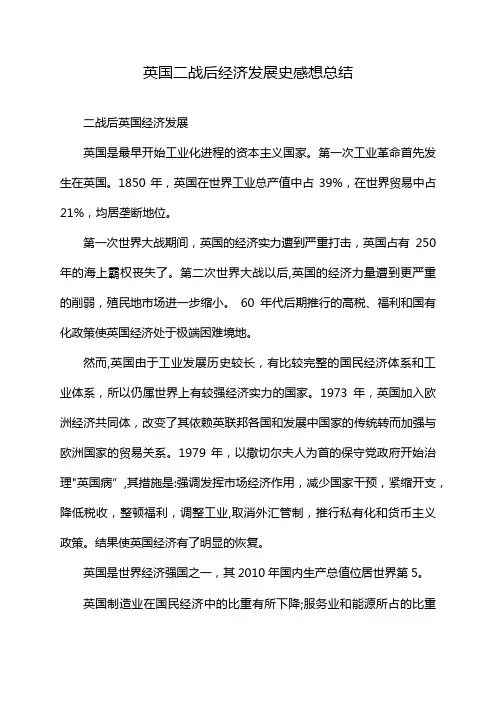
英国二战后经济发展史感想总结
二战后英国经济发展
英国是最早开始工业化进程的资本主义国家。
第一次工业革命首先发生在英国。
1850年,英国在世界工业总产值中占39%,在世界贸易中占21%,均居垄断地位。
第一次世界大战期间,英国的经济实力遭到严重打击,英国占有250年的海上霸权丧失了。
第二次世界大战以后,英国的经济力量遭到更严重的削弱,殖民地市场进一步缩小。
60年代后期推行的高税、福利和国有化政策使英国经济处于极端困难境地。
然而,英国由于工业发展历史较长,有比较完整的国民经济体系和工业体系,所以仍属世界上有较强经济实力的国家。
1973年,英国加入欧洲经济共同体,改变了其依赖英联邦各国和发展中国家的传统转而加强与欧洲国家的贸易关系。
1979 年,以撒切尔夫人为首的保守党政府开始治理"英国病”,其措施是:强调发挥市场经济作用,减少国家干预,紧缩开支,降低税收,整顿福利,调整工业,取消外汇管制,推行私有化和货币主义政策。
结果使英国经济有了明显的恢复。
英国是世界经济强国之一,其2010年国内生产总值位居世界第5。
英国制造业在国民经济中的比重有所下降;服务业和能源所占的比重
不断增大,其中商业、金融业和保险业发展较快。
旅游业是英最重要的经济部门之一。
年产值700多亿英镑,旅游收入占世界旅遊收入的5%左右。
与以风光旅游为主的国家不同,英国的王室文化和博物馆文化是旅游业的最大看点。
主要旅游点有伦敦、爱丁堡、加的夫、布赖顿、格林威治、斯特拉福、牛津、剑桥等。
英国是世界第四大贸易国,贸易额占世界贸易总额的5%以上,商品和劳务出口约占国内生产总值的25%。

第六章英国经济英国是世界上最老的工业国,工业革命首先发生在英国。
一个世纪前英国被称为"世界工广"。
英国生产出许多商品然后销往世界各地。
那时的英国经济属世界强国之林,生活水平远远高于欧洲邻国。
但是今非昔比。
二战后不久,英国不仅失去经济霸权,而且其工业领导地位也丢失大部分。
其人均国民生产总值在1900年被美国超过,1950年被法国和德国超过,1960年被意大利超过。
1950年至1973年间,英国的国民生产总值平均年增产率为3.0%,低于其大多数贸易伙伴。
经济发展受阻于长期收支差额赤字。
一个国家的收支差额是指出口所挣的货币与进口所花货币之间的差额。
当一个国家花在进口上的总货币量超过它在出口上得到的总货币量时,这个国家就遭受收支差额的赤字。
几十年来英国一直存在收支差额赤字。
在增长率上英国再也不能与其他工业国匹敌。
现在常用"英国病"这个词来概括英国经济衰退的特征。
I.二战后英国经济的演变二战后英国经济的发展有三个阶段:1.15年代和60年代的稳定发展二战蹂躏了欧洲。
战争使英国经济遭受巨大损失,但它所受的直接战争损失比其他欧洲国家和日本要小。
美国的援助使英国经济很快恢复。
被战争抑制的消费需求很快成了促进经济发展的重要因素。
到1947年底英国经济已恢复到战前水平。
1950年英国的国民生产总值及外贸列世界第二位(仅次于美国),人均收入列世界第三位。
这一时期英国经济的特点是发展缓慢但很稳定,失业少,物质的极度繁荣伴随着消费水平的提高。
像所有西方国家一样,英国把充分就业问题看作是战后经济的突出问题,它所奉行的经济政策以约翰·凯恩斯理论为基础。
他提出,政府在利用物价和收入政策从根本上抑制通货膨胀的同时,应该利用财政和货币政策来微调社会的总需求,以达到充分就业的目的。
这种以高消费和低投资为特点的政策也产生了一些问题,其中之一是劳动力费用昂贵,这反过来又导致英国在国际市场上竞争力低下。

案例名称:二战后西方国家的国有化浪潮案例适用:关于国家垄断资本主义案例内容:第二次世界大战结束后,一些西方国家在左翼政党执政时不同程度地推行国有化政策,将若干行业的私人企业改变为国有企业,形成了一股浪潮。
以下是几个典型国家的例子。
英国:英国战后的国有化是西方国家国有化的一个典型。
在1945年的大选中,保守党大败于工党。
1945~1951年艾德礼工党政府执政期间,英国掀起了第一次国有化高潮。
艾德礼政府对英国大工业,包括钢铁、煤炭、铁路、航空、电信和英格兰银行,实行国有化。
1974~1976年威尔逊工党政府执政期间,英国又掀起了第二次国有化高潮。
两次国有化高潮使国有工业在英国重要工业部门中的比重占据相当重要的地位。
据英国《经济学家》1978年12月30日一期的统计数字,国有经济在英国重要工业和交通部门中的比重是:石油25%,汽车50%,钢铁75%,航空75%,煤炭100%,电力100%,天然气100%,造船100%,铁路100%,邮政100%,电信100%。
法国:法国战后的国有化也具有典型意义。
法国全国抗敌委员会的纲领规定:“大型国有化生产资料归国家所有。
”(注:弗朗索瓦·卡龙:《现代法国经济史》,商务印书馆,1979年,第263页。
)1944~1946年戴高乐临时政府通过没收或赎买政策,将能源、银行、保险等行业的一些大型私人企业收归国有。
1946年宪法宣布:“所有一切已经具有和将要具有为全民服务或事实上具有和将要具有垄断性质的财富和企业必须全部成为全社会的财产。
”(注:弗朗索瓦·卡龙:《现代法国经济史》,商务印书馆,1979年,第263页。
)1946年底,法国国有企业在能源领域的比重高达90%,在金融领域的比重接近50%。
1981年5月,密特朗击败了在职的法国总统德斯坦,成为法国第一任社会党人总统。
同年6月,社会党又在议会选举中取得了绝对优势。
密特朗上台后,立即着手推行大规模的国有化,在法国掀起了国有化高潮。
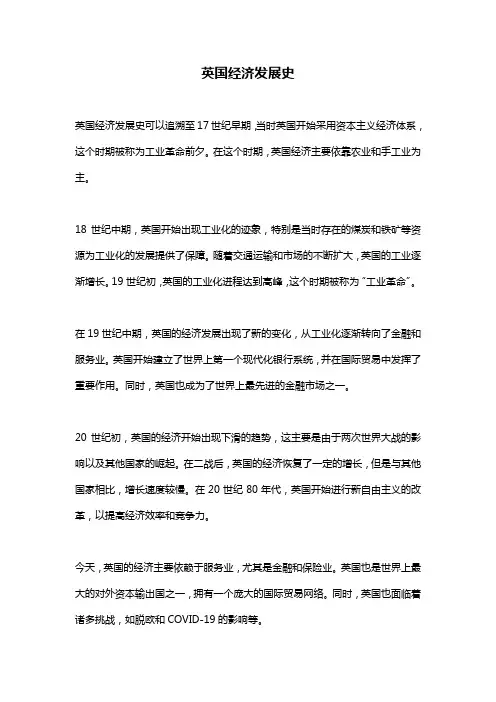
英国经济发展史
英国经济发展史可以追溯至17世纪早期,当时英国开始采用资本主义经济体系,这个时期被称为工业革命前夕。
在这个时期,英国经济主要依靠农业和手工业为主。
18世纪中期,英国开始出现工业化的迹象,特别是当时存在的煤炭和铁矿等资源为工业化的发展提供了保障。
随着交通运输和市场的不断扩大,英国的工业逐渐增长。
19世纪初,英国的工业化进程达到高峰,这个时期被称为“工业革命”。
在19世纪中期,英国的经济发展出现了新的变化,从工业化逐渐转向了金融和服务业。
英国开始建立了世界上第一个现代化银行系统,并在国际贸易中发挥了重要作用。
同时,英国也成为了世界上最先进的金融市场之一。
20世纪初,英国的经济开始出现下滑的趋势,这主要是由于两次世界大战的影响以及其他国家的崛起。
在二战后,英国的经济恢复了一定的增长,但是与其他国家相比,增长速度较慢。
在20世纪80年代,英国开始进行新自由主义的改革,以提高经济效率和竞争力。
今天,英国的经济主要依赖于服务业,尤其是金融和保险业。
英国也是世界上最大的对外资本输出国之一,拥有一个庞大的国际贸易网络。
同时,英国也面临着诸多挑战,如脱欧和COVID-19的影响等。
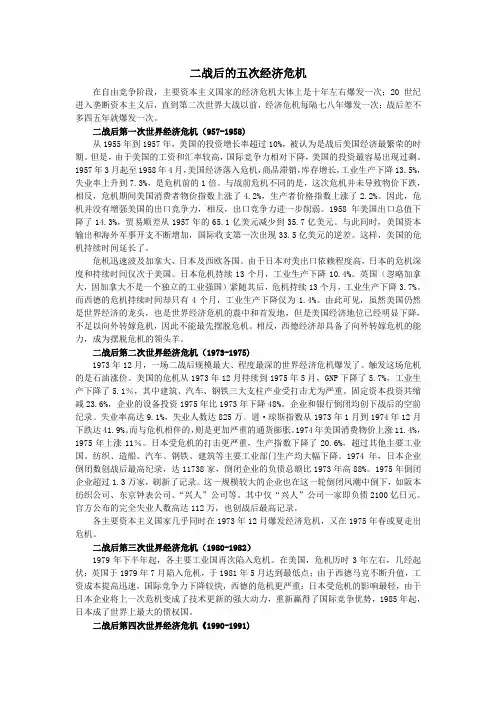
二战后的五次经济危机在自由竞争阶段,主要资本主义国家的经济危机大体上是十年左右爆发一次;20世纪进入垄断资本主义后,直到第二次世界大战以前,经济危机每隔七八年爆发一次;战后差不多四五年就爆发一次。
二战后第一次世界经济危机(957-1958)从1955年到1957年,美国的投资增长率超过10%,被认为是战后美国经济最繁荣的时期。
但是,由于美国的工资和汇率较高,国际竞争力相对下降,美国的投资最容易出现过剩。
1957年3月起至1958年4月,美国经济落入危机,商品滞销,库存增长,工业生产下降13.5%,失业率上升到7.3%,是危机前的1倍。
与战前危机不同的是,这次危机并未导致物价下跌,相反,危机期间美国消费者物价指数上涨了4.2%,生产者价格指数上涨了2.2%。
因此,危机并没有增强美国的出口竞争力,相反,出口竞争力进一步削弱。
1958年美国出口总值下降了14.3%,贸易顺差从1957年的65.1亿美元减少到35.7亿美元。
与此同时,美国资本输出和海外军事开支不断增加,国际收支第一次出现33.5亿美元的逆差。
这样,美国的危机持续时间延长了。
危机迅速波及加拿大、日本及西欧各国。
由于日本对美出口依赖程度高,日本的危机深度和持续时间仅次于美国。
日本危机持续13个月,工业生产下降10.4%。
英国(忽略加拿大,因加拿大不是一个独立的工业强国)紧随其后,危机持续13个月,工业生产下降3.7%。
而西德的危机持续时间却只有4个月,工业生产下降仅为1.4%。
由此可见,虽然美国仍然是世界经济的龙头,也是世界经济危机的震中和首发地,但是美国经济地位已经明显下降,不足以向外转嫁危机,因此不能最先摆脱危机。
相反,西德经济却具备了向外转嫁危机的能力,成为摆脱危机的领头羊。
二战后第二次世界经济危机(1973-1975)1973年12月,一场二战后规模最大、程度最深的世界经济危机爆发了。
触发这场危机的是石油涨价。
美国的危机从1973年12月持续到1975年5月,GNP下降了5.7%,工业生产下降了5.1%,其中建筑、汽车、钢铁三大支柱产业受打击尤为严重。
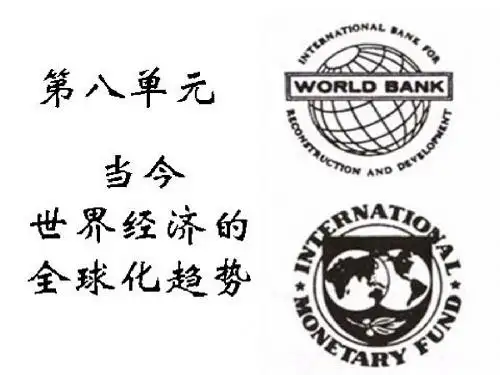
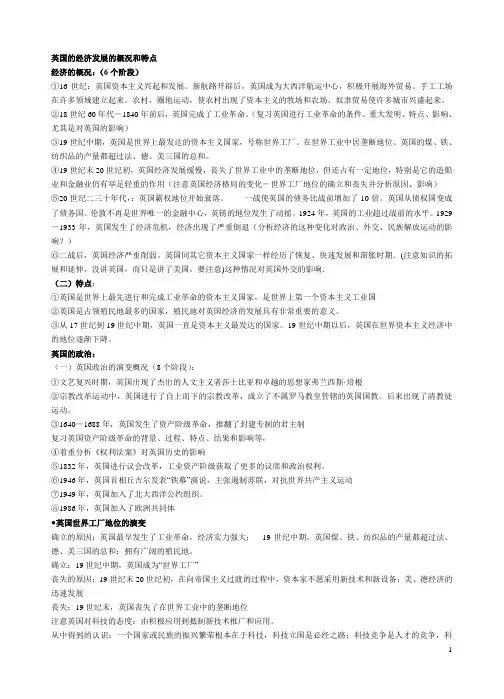
英国的经济发展的概况和特点经济的概况:(6个阶段)①16世纪:英国资本主义兴起和发展。
新航路开辟后,英国成为大西洋航运中心,积极开展海外贸易。
手工工场在许多领域建立起来。
农村,圈地运动,使农村出现了资本主义的牧场和农场。
奴隶贸易使许多城市兴盛起来。
②18世纪60年代-1840年前后,英国完成了工业革命。
(复习英国进行工业革命的条件、重大发明、特点、影响、尤其是对英国的影响)③19世纪中期,英国是世界上最发达的资本主义国家,号称世界工厂。
在世界工业中居垄断地位、英国的煤、铁、纺织品的产量都超过法、德、美三国的总和。
④19世纪末20世纪初,英国经济发展缓慢,丧失了世界工业中的垄断地位,但还占有一定地位,特别是它的造船业和金融业仍有举足轻重的作用(注意英国经济格局的变化-世界工厂地位的确立和丧失并分析原因、影响)⑤20世纪二三十年代,:英国霸权地位开始衰落。
一战使英国的债务比战前增加了10倍。
英国从债权国变成了债务国。
伦敦不再是世界唯一的金融中心,英镑的地位发生了动摇。
1924年,英国的工业超过战前的水平。
1929-1933年,英国发生了经济危机,经济出现了严重倒退(分析经济的这种变化对政治、外交、民族解放运动的影响?)⑥二战后,英国经济严重削弱。
英国同其它资本主义国家一样经历了恢复、快速发展和滞胀时期.(注意知识的拓展和延伸,没讲英国,而只是讲了美国,要注意)这种情况对英国外交的影响.(二)特点:①英国是世界上最先进行和完成工业革命的资本主义国家,是世界上第一个资本主义工业国②英国是占领殖民地最多的国家,殖民地对英国经济的发展具有非常重要的意义。
③从17世纪到19世纪中期,英国一直是资本主义最发达的国家。
19世纪中期以后,英国在世界资本主义经济中的地位逐渐下降。
英国的政治:(一)英国政治的演变概况(8个阶段):①文艺复兴时期,英国出现了杰出的人文主义者莎士比亚和卓越的思想家弗兰西斯·培根②宗教改革运动中,英国进行了自上而下的宗教改革,成立了不属罗马教皇管辖的英国国教。
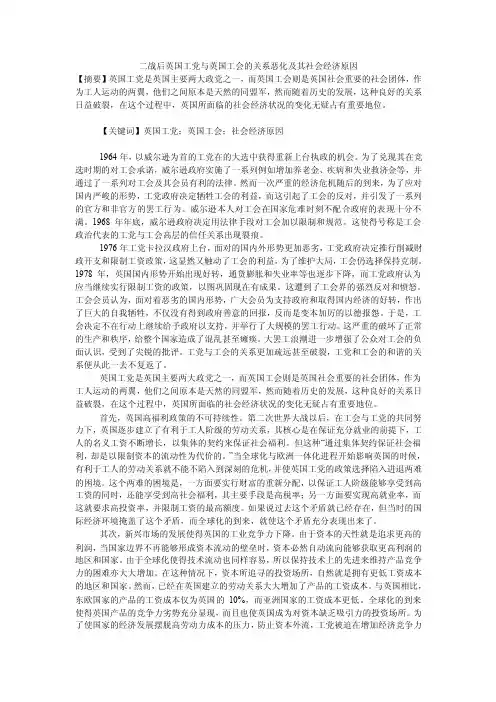
二战后英国工党与英国工会的关系恶化及其社会经济原因【摘要】英国工党是英国主要两大政党之一,而英国工会则是英国社会重要的社会团体,作为工人运动的两翼,他们之间原本是天然的同盟军,然而随着历史的发展,这种良好的关系日益破裂,在这个过程中,英国所面临的社会经济状况的变化无疑占有重要地位。
【关键词】英国工党;英国工会;社会经济原因1964年,以威尔逊为首的工党在的大选中获得重新上台执政的机会。
为了兑现其在竞选时期的对工会承诺,威尔逊政府实施了一系列例如增加养老金、疾病和失业救济金等,并通过了一系列对工会及其会员有利的法律。
然而一次严重的经济危机随后的到来,为了应对国内严峻的形势,工党政府决定牺牲工会的利益,而这引起了工会的反对,并引发了一系列的官方和非官方的罢工行为。
威尔逊本人对工会在国家危难时刻不配合政府的表现十分不满。
1968年年底,威尔逊政府决定用法律手段对工会加以限制和规范。
这使得号称是工会政治代表的工党与工会高层的信任关系出现裂痕。
1976年工党卡拉汉政府上台,面对的国内外形势更加恶劣,工党政府决定推行削减财政开支和限制工资政策,这显然又触动了工会的利益,为了维护大局,工会仍选择保持克制。
1978年,英国国内形势开始出现好转,通货膨胀和失业率等也逐步下降,而工党政府认为应当继续实行限制工资的政策,以图巩固现在有成果。
这遭到了工会界的强烈反对和愤怒。
工会会员认为,面对着恶劣的国内形势,广大会员为支持政府和取得国内经济的好转,作出了巨大的自我牺牲,不仅没有得到政府善意的回报,反而是变本加厉的以德报怨。
于是,工会决定不在行动上继续给予政府以支持,并举行了大规模的罢工行动。
这严重的破坏了正常的生产和秩序,给整个国家造成了混乱甚至瘫痪。
大罢工浪潮进一步增强了公众对工会的负面认识,受到了尖锐的批评。
工党与工会的关系更加疏远甚至破裂,工党和工会的和谐的关系便从此一去不复返了。
英国工党是英国主要两大政党之一,而英国工会则是英国社会重要的社会团体,作为工人运动的两翼,他们之间原本是天然的同盟军,然而随着历史的发展,这种良好的关系日益破裂,在这个过程中,英国所面临的社会经济状况的变化无疑占有重要地位。
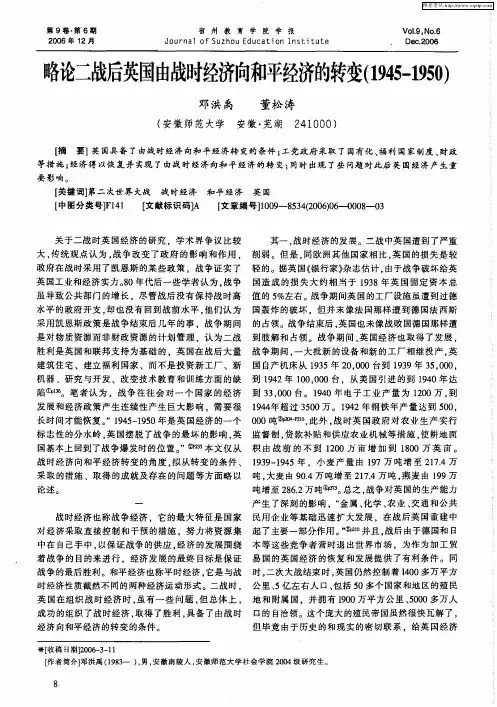

第26讲 二战后各国经济体制的调整【考纲要求】1.第二次世界大战后美国等国资本主义新变化的原因、表现。
2.赫鲁晓夫改革、勃列考点一 战后资本主义的新变化【基础落实】一 国家垄断资本主义的发展1.从二战结束到20世纪70年代初期:西方资本主义国家普遍奉行国家干预的经济政策,出现了经济发展的“黄金时期”。
2.20世纪70年代初:欧美主要资本主义国家出现“滞胀”现象。
3.20世纪80年代以来:欧美各国适当减小了国家对经济的干预,逐渐发展出一种将政府干预与市场相结合的、国有制与私有制并存的“混合经济”。
二 建立“福利国家”1.目的:为了缩小贫富差距,减少因贫困引发的社会问题。
2.实质:国家运用社会保障政策和社会服务开支,保障个人和家庭的最低收入,保障其经济安全。
3.历程:20世纪六七十年代日渐完备;70年代后受挫,但是继续发展;80年代以后,缩小“福利国家”的规模。
4.评价(1)一定程度上保障了人民的利益,对社会稳定起到了一定的积极作用。
(2)助长了部分人的惰性,导致国家财政不堪重负。
三 第三产业的兴起和“新经济”的出现 1.第三产业的兴起(1)原因:科学技术的进步、社会生产力的发展、公众生活水平的提高及消费需求的多样化。
(2)表现:成为国民经济中增长速度最快的部门。
(3)作用⎩⎪⎨⎪⎧①拓展了经济活动领域,增加了就业,扩大了市场,改善了资源配置。
②缓和了经济的周期性波动,使经济发展产生了质的变化。
2.“新经济”的出现(1)背景:二战后,美国发展新兴产业;经济全球化和信息技术革命的推动。
(2)形成:20世纪90年代初开始,美国经济出现了10年的持续增长,“新经济”问世。
(3)特点:以知识经济为基础、以信息技术为主导的新的经济形态。
【考点深化】1.二战后资本主义经济运行机制调整的表现(1)二战后~70年代:二战后,发达资本主义国家纷纷效仿罗斯福政府而实施了国家对经济的全面干预。
主要措施有:加大国有化程度;尽量扩大就业;普遍建立福利制度;政府直接参与并主导国民收入再分配等。
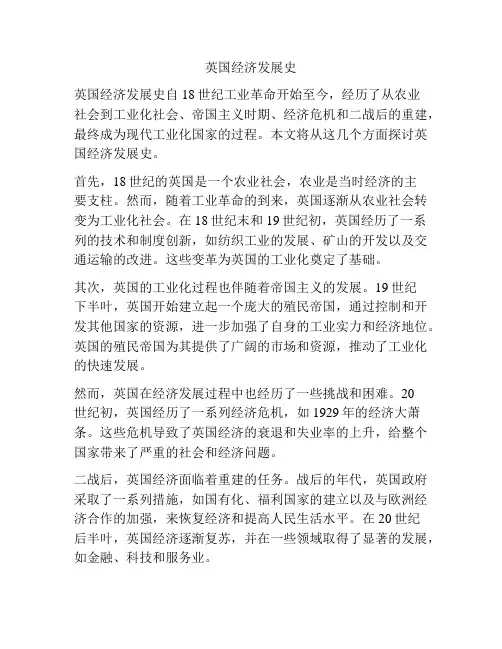
英国经济发展史英国经济发展史自18世纪工业革命开始至今,经历了从农业社会到工业化社会、帝国主义时期、经济危机和二战后的重建,最终成为现代工业化国家的过程。
本文将从这几个方面探讨英国经济发展史。
首先,18世纪的英国是一个农业社会,农业是当时经济的主要支柱。
然而,随着工业革命的到来,英国逐渐从农业社会转变为工业化社会。
在18世纪末和19世纪初,英国经历了一系列的技术和制度创新,如纺织工业的发展、矿山的开发以及交通运输的改进。
这些变革为英国的工业化奠定了基础。
其次,英国的工业化过程也伴随着帝国主义的发展。
19世纪下半叶,英国开始建立起一个庞大的殖民帝国,通过控制和开发其他国家的资源,进一步加强了自身的工业实力和经济地位。
英国的殖民帝国为其提供了广阔的市场和资源,推动了工业化的快速发展。
然而,英国在经济发展过程中也经历了一些挑战和困难。
20世纪初,英国经历了一系列经济危机,如1929年的经济大萧条。
这些危机导致了英国经济的衰退和失业率的上升,给整个国家带来了严重的社会和经济问题。
二战后,英国经济面临着重建的任务。
战后的年代,英国政府采取了一系列措施,如国有化、福利国家的建立以及与欧洲经济合作的加强,来恢复经济和提高人民生活水平。
在20世纪后半叶,英国经济逐渐复苏,并在一些领域取得了显著的发展,如金融、科技和服务业。
然而,在过去几十年里,英国经济也面临了一些新的挑战和变化。
全球化和信息技术的发展,使得英国面临着来自其他国家的竞争压力。
此外,英国脱欧也给经济带来了不确定性和挑战。
这些问题对英国经济的发展产生了一定的影响。
总的来说,英国经济发展史是一个充满变革和挑战的过程。
从农业社会到工业化社会,再到现代工业化国家,英国经历了一系列的发展阶段。
在这个过程中,英国通过技术创新、帝国主义和重建等手段,不断推动经济的发展。
然而,英国经济也面临着一些问题和困难,需要不断适应和应对。
未来,随着全球经济的变化和新的挑战的出现,英国经济将继续面临各种机遇和挑战。
二战后英国政府金融政策对其汽车工业的影响[摘要] 二战后,作为国家经济的支柱产业,英国汽车工业在政府政策的指导和高度关注下,得到了长足发展,但也遇到了很多问题,研究这一问题有助于我们更好地了解和分析英国政府与其汽车工业兴衰之间的关系。
[关键词] 二战后英国金融政策汽车工业影响在1914年前的主要汽车生产国中,英国是最后一个建立起大型汽车工业的国家,二战后英国一度成为世界第二大汽车生产国和最大的轿车和商用车出口国。
然而从20世纪60年代中期开始,英国汽车工业急速衰落。
与欧洲大陆、美国和日本的主要汽车生产国在汽车出口量上相比,英国的份额在80年代已经下降了一半。
到1989年,英国本土最大的汽车制造商—英国利兰(BL)也是被政府出售了;罗孚汽车公司(Rover)成为了英国航空公司的子公司,捷豹(Jaguar)、阿斯顿·马丁(Aston Martin)和莲花(Lotus)也卖给了美国福特公司,而劳斯莱斯(Rolls Royce)的车间工厂被维克斯公司(Vickers军工企业)获得,商用车生产公司则被荷兰公司DAF获得,自此,曾经独立发展的英国汽车工业完全被转让了。
英国汽车工业衰落的速度和影响程度是英国战后经济史中最戏剧性的经济发展之一。
影响英国汽车工业发展的因素有很多,尤以政府的产业政策思维的前后调整,对英国汽车工业的发展造成了深远的影响。
这其中表现比较突出的是政府的金融政策对汽车工业的影响。
1、保卫英镑政策(protect the value of sterling)金融政策中的货币政策是指“中央银行为实现宏观经济调控目标而采用各种方式调节货币供应量进而影响宏观经济的方针和政策的总称”。
战后英国的货币政策主要是为了达到国际收支平衡(the balance of payments)这一目标。
国际收支是指一个国家因开展进出口贸易和参与国际分工等国际经济活动,与其他国家发生的货币收支。
国际收支的过度逆差或者顺差,对一国的社会经济发展都是不利的。
战后英国国家干预经济发展战略评析国家干预,是指国家有意识地运用政府的资源和权力来调节经济活动。
从20世纪三四十年代以来,世界范围内的经济局势的动荡,已经使英国乃至欧洲历史上传统的资本主义经济模式受到了挑战。
为了应对当时的经济困境,重建英国经济,英国政府开始实施国家干预经济发展策略。
20世纪30年代以来,英国经济发展一直处于低迷状态,它的重要表现就是贸易萧条、失业率上升、英镑贬值的现象出现。
为了改善这种现象,英国政府开始实施国家干预经济发展策略。
首先,英国在二战结束后,政府采取积极的财政政策,大力发展国家经济,为一般民众提供了大量的就业机会。
1950年,英国政府推出了广泛的就业保障措施,让民众享受到了公平就业、安全就业和合理工资待遇。
同时,政府还实施了大规模的退休金、伤残津贴和社会保险等社会福利措施,确保人们的收入状况得到改善。
其次,英国政府实施国家占有性经济政策。
在二战后初期,政府扩大了集中控制机构的规模,并通过保护主义向政府企业提供了大量金融资金,促进其发展。
此外,政府还改善了行政机构的组织结构和职能,提高了行政机构的职能和效率,推动了经济社会结构的改善和更新。
最后,英国政府实施了开放经济政策,取消了立法限制,并为外商投资营造良好的投资环境,大量的外商投资使英国经济有了改善,有利于吸引更多外商投资,激发经济增长,不断地改善生活水平。
从以上分析可知,英国政府在二战后实施的国家干预经济发展策略,使英国经济得到了重大发展,使英国在世界经济中发挥了重要作用,起到了非常重要的促进作用。
因此,国家干预经济是英国现代经济发展的一个重要原因,也是一种有效的政府调节经济政策。
英国经济发展历程In the 18th century, Britain was the first nation to start industrial revolution. Through its expansive colonial empire and technological superiority, the British economy was dominant in the world. By 1880s, Britain produced one-third of the world’s manuf actured goods, known as “workshop of the world”.18世纪的英国是全球第一个发生工业革命的国家。
随着日不落帝国的殖民地扩张,以及工业革命带来的科技优势,英国在全球经济中发挥着举足轻重的作用。
到19世纪末, 英国包揽了全球三分之一的工业品生产总量,被誉为“世界工场”。
By 1900, however, it had been overtaken by both the United States and Germany. The cost of the two World War weakened the UK's relative global dominance. It suffered a deep loss of its position of industrial leadership. But in the 21st century the UK still projects significant influence in the world economy.然而到了1900 年,美国和德国的经济实力已赶超英国。
两次世界大战,相对削弱了英国的全球影响力,英国严重丧失了其工业领先地位。
但进入21 世纪之后,英国经济复苏,对世界经济依然产生着巨大影响。
The Economy of United Kingdom after World War Ⅱ二战后的英国经济CONTENTAbstract: (1)Key word: (1)1. The current situation of English economy (2)2. The decline of English economy after world war Ⅱ (2)3. The reasons of the decline of British economy (2)3.1. British heavily debt because of financing the war (2)3.2. India got out of the British control. (3)3.3. Britain spent a higher proportion of its national wealth on the military. (3)3.4. British older equipment made the output low than others. (3)3.5. The failure to invest sufficiently in industry (3)4. The resuscitation of English economy in Margaret Thatc her’s government (4)4.1. Macroeconomic measures (5)4.2. Microeconomic policies (5)4.3. Some explanation about Margaret Thatcher’s government (5)4.3.1. Free-market economic theory (6)4.3.2. Thatcher Governmen t’s Medium-term Financial Strategy (6)4.3.3. The meaning of British disease (6)5. Soft Policies Adopted by Post-war Governments (6)6. The Impetus to Change from Defeat in War (7)7. The Current British Economy (7)7.1. Primary Industries (8)7.2. Secondary industries (8)7.3. Tertiary Industries (9)8. British several industries and its present agriculture (11)8.1. British coal mining (11)8.2. British oil and natural gas (11)8.3. British iron and steel industry (11)8.4. British textile industry (11)8.5. Britain’s agriculture (12)8.6. The change of Britain’s trade pattern (12)9. Conclusion (12)Work cited (14)The Economy of the United Kingdom after World War ⅡAbstract: Before the World War Ⅱ, Britain was the oldest industrial country in the world. By the 1880s, British economy was dominant in the world.Although by 1900 this was no longer the case, and the United Kingdomhad been overtaken by both the United States and Germany, Britain stillhad an obvious advantage of economy. However, after World War Ⅱ, it isstainable but misleading, and there is a period as one of decline. Maybethis decline is relative to some other economies rather than absolute, butthis relative failure is a serious cause of concern to the British internalcondition.Key word: the economy of the United Kingdom, World War Ⅱ, decline, the reasons of decline, resuscitation, Margaret Thatcher’s government, soft policies,current British economy, primary industries, second industries, tertiaryindustries, British industries, British agriculture.The Economy of The United Kingdom after World War Ⅱ1. The current situation of English economyThe United Kingdom of Great Britain is a major developed capitalist country. It is now the world’s sixth largest economy and has a gross domestic product (GDP) of US&2 645 billion (2010) and is forecast to have the strongest business environment of all major European economies for the period 2007 to 2011. The United Kingdom is not only a member of the G7, G8, G-20 major economies, but also a member of the World Trade Organization. It is a leading global trading nation, as the second largest exporter and third largest importer of commercial services, and the tenth largest exporter and sixth largest importer of merchandise (2007).2. The decline of English economy after world war ⅡHere, we mainly talk about the British Economy after World War Ⅱ.Britain is the oldest industrial country in the world. By the 1880s, British economy was dominant in the world; producing one third of the world’s manufactured goods, half its coal and iron, half its cotton. The amount of British shipping was greater than that in the rest of the world put together. Although by 1900 this was no longer the case, the United Kingdom having been overtaken by both the United States and Germany, Britain still had an obvious advantage of economy. Unfortunately, certainly from 1945 until the present, it is stainable but misleading, as it has in fact been a period of steady economic growth and rapidly increasing living standards. Britain remains one of the Group of Seven large industrial economies. But there are reasons for describing this period as one of decline. Britain entered the post-war world as one of successful allies of the Second World War, with some of its chief competitor nations such as Germany and Japan, economically destroyed. Also Britain was the center of a still vast empire. According to the figures, the United Kingdom was second only to the United States in the international economy. Thus Britain was then in an apparently strong economic position, a position it clearly no longer occupies, which indicates some sort of decline. And the basic positive-seeming facts describing the size of economy, the high proportion of world trade that was British, and so on, in 1945, did not reveal important negative facts about the United Kingdom’s position even then.3. The reasons of the decline of British economyThere are several reasons explaining the appearance.3.1. British heavily debt because of financing the warThe country had gone heavily into debt in order to finance the war, selling many of its accumulated overseas assets, and borrowing large amounts from the UnitedStates and Canada. These debts meant that the United Kingdom entered the post-war era with a major economic problem.3.2. India got out of the British control.The era of empire was over. India, popularly known as “The Jewel in the Crown”of the British Empire, gained its independence in 1947, only 2 years after the end of the war. This was the largest element in the empire, providing raw materials and a big market for British goods. This relationship with India was no longer available, and the rest of the empire quickly followed India to independence, leaving Britain as just a medium-size European country, with a population only one fifth the sizes of the U.S.3.3. Britain spent a higher proportion of its national wealth on the military.Despite the relatively rapid and trouble-free process of decolonization, Britain was still forced to maintain a substantial and expensive military presence in many overseas locations until the process was completed (mostly by the end of the 1960s). Also its position as one of the shapers of the post-war world required substantial military contributions – both as one of the NATO’s major partners, and as a member of the UN Security Council. All this had the result that Britain spent a higher proportion of its national wealth (and especially of its research and development budget) on the military than most of its competitors. Military expenditure tends not to generate an economic return in quite the same way as other industrial investment.3.4. British older equipment made the output lower than others.Although Britain was quite badly damaged by German bombing during the war, its industry survived comparatively unaffected. This contrasted greatly with some of its competitors – especially the main losers in the conflicts, Germany and Japan, who almost had to start again from nothing. This apparent disadvantage for them may have worked in their favor in that as they had to invest, they could invest in the most modern equipment and new products. British industry, however, could continue with its older factories and pre-war products, and give its other economic problems, did so – a problem in the long-term. It also meant that output was initially very low in these two potentially large economies: so while Britain looked securely wealthier than them in 1945, a catching-up with the United Kingdom was inevitable as they recovered.3.5. The failure to invest sufficiently in industryThe failure to invest sufficiently in industry also reflects a long-standing and continuing problem in the United Kingdom economy. Even without the particular circumstances of the post-war world, relatively low rates of investment (the amount of money businesses put aside from profits to reinvest in the business in new products and production methods) were characteristic of the British economy in relation to other developed economies. Economists have pointed to the lack of close relationshipbetween industry and banks in the United Kingdom – again the contrast, particularly with the two most successful post-war economy, Japan and Germany, where banks and industrial firms have very close links. Economic historians have suggested that this may be due to the fact that the United Kingdom was the first economy to industrialize, and industrial firms, without foreign competition, grew used to financing their own development, without need to borrow from banks. Banks therefore, not able to find good investment opportunities in the United Kingdom, looked overseas for investment opportunities. A low rate of domestic industrial investment coupled with a very high rate of overseas investment is still a characteristic of the United Kingdom economy. So, amongst European nations, Britain is the largest investor in China, but sells fewer of its own manufactured goods here than do Germany or France.The point to note is that the comparatively strong economic position Britain found itself in 1945 was in many ways deceptive. So the decline from Britain’s apparently good fortunes at that point until now is thus not as extraordinary as it might seem, being the result of already existing basic problems. And it should also be remembered that this was not an absolute decline: Britain is not poorer, or producing less than it was in 1945, in fact (like most countries) it is a lot wealthier and more productive than it was then. The problem is that though it has improved, other counties have improved more rapidly, hence the slide from being the 2nd largest economy (after the United States) to being the sixth, as it is at present. And even many smaller economies have overtaken the United Kingdom in terms of output per head of population. So the United Kingdom has experienced economic decline, but this decline is relative to some other economies rather than absolute. Nevertheless, this relative failure is a serious cause of concern to the United Kingdom governments.4. The resuscitation of English economy in Margaret Thatcher’s governmentThe phenomenon culminated in the winter of 1979 when there were widespread strikes. The Labor government faced a vote of no confidence, which it lost, causing a general election. This was won by the Conservatives under their leader Margaret Thatcher, who thus became the United Kingdom’s first woman Prime Minister.She was a radical in conservative terms, committed to the idea of small government and free-market economics, and less concerned with being “fatherly” this she dismissed as the “nanny state”, encouraging laziness and discouraging entrepreneurship. As a result the 1980s saw the most substantial changes to British society since the late 1940s. Part of the change was to undo some of the work of that 1945 Labor government, because one of their major policies was the privatization of nationalized industry: British Aerospace; British Airways; British Telecom; British Petroleum; the electricity, gas and water companies, and many others, including much public housing, were gradually sold off, until today when little remains to be sold. The policy is generally seen as a success because the privatized companies have done very well, becoming very efficient and profitable. There were negative consequences; however, as the process of becoming efficient enough for private investors to buy them involved all these huge businesses in the loss of many workers. Sounemployment went up quickly in the early 1980s, from 1 million jobless to 3.5 million. So poverty has increased for the first time since the War. Government welfare payments have become less generous too. So through the 1980s many people got richer and many got poorer: Britain became a less equal society, and many thought public services, such as health, education and transport, got worse. The leader of the liberal party described the 1980s as a time of “private affluence and public squalor”. Nevertheless many businesses boomed, and simplified government regulations attracted many foreign businesses.From a clearer aspect, we know that Thatcher’s government adopted a Medium-term Financial Strategy and took numerous to improve the efficiency of the economy during the past decade, using both macroeconomic and microeconomic policies.4.1. Macroeconomic measures●The aim: to bring down the rate inflation and achieve price stability.●The measures: to apply a tight control on the exchange rate and the regulation ofmoney growth. This monetary policy was complemented by a firm fiscal policy to reduce public borrowing.4.2. Microeconomic policies●The aim: to work with the grain of market forces by encouraging enterprise,efficiency and flexibility.●The seven policies:Privatization of some state –owned enterprises;Deregulation and market liberalization replacing prices and incomes control and state intervention;Emphasis on improving the long run supply performance of the economy;Labor legislation to change labor-capital relation for the good;Reform of taxation stimulates private investment;Control over foreign transactions, company dividends, installment purchase and bank lending were abolished;Encouraging competition is among financial institutions.Owing to the Thatcher programmed, the British in the 1980s developed quite significantly. Mrs. Thatcher tried to cure the “British disease”but she failed in the end.4.3. Some explanation about Margaret Thatcher’s governmentThere are some proper nouns in Margaret Thatcher’s government. Next, some explanation is as follows.4.3.1. Free-market economic theoryIt is an economic theory put forward by John M. Keynes, a British economist in the first half of the twentieth century. It hold that the government should use fiscal and monetary policy to fine-tune aggregate demand to achieve full employment, while using prices and incomes policies to suppress inflation at source. This policy is characterized by high consumption and low investment.4.3.2. Thatcher Government’s Medium-term Financial StrategyThatcher Government’s Medium-term Financial Strategy in many ways represented a break with that of its predecessors. Its theory turned Keynesianism on its head. Privatization, deregulation and market liberalization replaced prices and incomes control and state interventionism. Unlike earlier Keynesian approach the new approach placed emphasis on improving the long-run supply-side performance of the economy.4.3.3. The meaning of British diseaseBritain is the oldest industrial country in the world. However, soon after World War Ⅱ, Britain gave up its economic hegemony. Its GDP growth rate became lower than that of its trading partners. It has been running balance of payments deficits for many decades. As a result the British pound has fallen into its lowest level. Britain is no longer able to match the growth rates of other industrial counties. The term “British disease” is now often used to characterize Britain’s economic decline.5. Soft Policies Adopted by Post-war GovernmentsIn principle, there were two broad strategies which British governments might have adopted after the war. The first was a market solution, in which the economy was deregulated and producers exposed to competitive pressures. The advantage of this strategy was that competition will penalize firms with, say, weak management or poor industrial relations. This was broadly the type of strategy which West Germany adopted after 1948, with some success. Such policies were also pursued by the Thatcher Government in the 1980s, when, as already noted, there was some improvement in Britain's relative performance. The obvious implication was that it would have been better if British governments had moved in this direction earlier. However, this conclusion may be unsustainable. For one thing, it waits to be seen if Britain's improved performance can be sustained through the 1990s. For another, there are reasons to doubt whether a market solution is always appropriate. If, for example, low growth has been due to an underinvestment in education then a market solution will not solve the problem.The alternative strategy would have been to introduce a state-led modernizationprogram. This was the direction which both France and Japan took after the war with some success.4 British economic policy, with the adoption of demand management, nationalization and active industrial, regional and manpower measures also became much more interventionist after the war. Yet, these policies seem to have been less effective. Why?One possibility has been canvassed by Corelli Barnett. He has argued that the need for a modernization strategy was clearly recognized by the wartime administration. Yet it never materialized after the war, because the immediate policy priority became the establishment of the welfare state. Barnett is probably wrong to put so much emphasis on the welfare state, which, judging from expenditure levels has been no more prominent in Britain than in other European countries. Nevertheless, he is correct to argue that Britain never developed a modernization strategy.Why did Britain not develop a modernization strategy? It is was not the intention to argue here that Britain would have achieved an economic miracle if she had been defeated in 1945. Nevertheless, the Table does did show that a number of countries, which were defeated or occupied during the Second World War, were extremely successful thereafter. One possible reason for this is that wartime damage created exceptional investment opportunities. However, this could not be the whole story; their above average performance was sustained for too long. Another possibility, suggested by Mansur Olson, is that, when a country is defeated in a war, this will lead to a change in its attitudes and policies. Business and labor become receptive to change, while governments are likely to push through unpalatable reforms and to adopt modernization policies.6. The Impetus to Change from Defeat in WarWartime victors, by contrast, are less likely to do this. There will be less impetus to change, and governments will prefer to adopt policies which reward the population for their wartime sacrifices. This is essentially what happened in Britain after 1945. At this time there was extensive state intervention, but it was not to foster modernizing as in France and Japan. Rather the overriding priority was to correct the principal economic deficiency of the interwar years - high unemployment. Thus Britain never had a modernization strategy; it was effectively a strategy for containing unemployment. Similarly, wartime victory encouraged British governments to persist with international policies of questionable economic value. Thus, in the 1950s, Britain remained a colonial power, which restricted her freedom of action, without providing many obvious economic benefits. At the same time, she continued to act as a world policeman, and was obliged to maintain higher levels of defense expenditure than her international competitors, and this generated few economic benefits.7. The Current British EconomyThe national economies of Britain can be broken down into three main areas: “Primary” industries, such as agriculture, fishing, and mining; “Secondary” industries,which manufacture complex goods from those primary products; and “Tertiary”industries, often referred to as services, such as banking, insurance, tourism, and the selling of goods.7.1. Primary IndustriesThe British agriculture is highly efficient by the standard of France and Germany . It produces 1.4% of the national wealth, with only 2% of the labor force that grow 58 % of the food needed by the nation. The high rate of production is due to the extensive use of modern technical improvements.Only parts of the country have good soil, and farmland is scare. The quarters of Britain's land is used for agriculture, with about a quarter of undercrops--wheat and barley are the two commonest. The farmland in the eastern half of the country is used for raising crops. Its chief agricultural products are wheat, barley, oats, potatoes and sugar beets. The rest is used for grazing animals, including cattle (both dairy and beef), though sheep are the most numerous livestock. Dairy farming is distributed all over the country but is characteristic of the west of England. Britain is the world's leading exporter of pedigree livestock: cattle, sheep, pigs, and horses. Cattle are bred for meat as well as for dairy farming. Sheep are found in hilly counties particularly and are bred chiefly for their meat. Britain's beef, especially the best Scottish meat, is well known for its excellence, and Welsh mutton is the favorite meat in the country. The beef industry has been hit badly by BSE disease in cattle leading to a 1996 ban on beef exports. The best agricultural land is in the southeast of England.Britain has a large ocean fishing fleet and fish is a basic item in the national diet. The fishing industry provides 55% of the United Kingdom demand for fish. The leading fish caught are cod, haddock, herring, plaice, turbot and sole. The major fishing areas are the North Sea, the English Channel, the sea area around Ireland and the sea area between English and Iceland. Scottish ports land the majority of the fish caught.Energy production is an important part of the British economy, account for 5% of the national wealth. Since 1970s, when oil and gas were discovered under the North Sea, Britain has become a major oil and gas producer, in addition to its older coal mining industry, which now accounts for only about a quarter of energy supplies, the rest being divided between oil, gas, and nuclear energy. This abundance of energy resources means that the United Kingdom has become an overall exporter of energy. The technology required to extract oil from the difficult offshore conditions has given British companies a strong position in the offshore oil industry around the world. Three of the biggest ten companies in Britain are to be found in the energy sector: Shell (half Dutch), British Petroleum (BP), and British Gas. The world's largest mining company, RTZ, is a United Kingdom company, which operates mines all over the world.7.2. Secondary industriesIn the secondary sector of the economy, manufacturing industry remains important, producing 22% of national wealth. Britain companies are active in all major fields of manufacturing industry, but are particularly strong in pharmaceutical (Glaxo-Wellcome, the British company is the biggest drug company in the world), chemicals (including plastics, petrochemicals and pharmaceutical industry, ICI being the second largest paint manufacturer in the world), aerospace (overall the United Kingdom industry is third in size in the world, with such products as VC 10, the Trident, the BAC One-Eleven, and a range of military aircraft including the Jaguar, and the Harrier, a vertical take-off and landing strike aircraft, and the Concorde, the Anglo-French supersonic airliner) and food and drink (Scottish whisky being c major export). Britain has a big electronics industry (the fourth largest in the world, which produces such products as radar, computers, radio and television transmitting equipment, industrial control equipment and consumer goods) but like the car industry (which includes Ford, GM, Peugeot, Nissan, and Toyota) is in many cases foreign-owned. Britain's last major independent car company, Rover, was recently bought by the German company BMW. A high-technology engineering industry has developed around the motor-racing business, with many of the world's racing cars, both for Formula One and the American Indy Car series, being designed and built in Britain. McLaren and Williams are two of the most successful of these companies. The recently privatized British Steel is the world's fourth largest steel company. Other manufacturing industries include mechanical engineering that produces all forms of machinery and industrial plant; instrument engineering, with a product range extending from scientific instruments to photographic equipment and time-pieces; electrical engineering, engaged in the manufacture and installation of generation, transmitting and distribution equipment, telecommunications and broadcasting apparatus, specialized laboratory equipment and domestic electrical appliances. The other leading traditional industries include shipbuilding, textiles, locomotives, food products and consumer goods.7.3. Tertiary IndustriesLike most developed economies, Britain has seen a relative shrinking of the importance of secondary industry and a spectacular growth in tertiary or service industries, which now produce 65% of national wealth. A lot of this domestic activity such as retailing, tourism, insurance, and so on, but British is also a major international provider of services, accounting for about 10% of the world's exports of such services. 70% of the United Kingdom's work force is employed in the service sector.Trade is Britain's lifeline. Britain's geographical position makes it a natural transfer point. It imports many goods that are immediately re-exported to other countries in smaller lots, sometimes after some minor processing. Britain remains one of the world's most important trading nations. It exports about one-sixth of the total world exports of manufactured goods. It buys about one-fifth of the raw materials exported in the world.Britain's traditional customers in trade were the Commonwealth countriesand its former colonies. Its trade with highly industrialized nations has gone up since it joined the European Economic Community (the Common Market) in 1973. Apart from the Common Market, the United States and Canada are also its important customers in trade now.The invisible trade makes a great contribution to Britain's balance of payment problems. Earnings from tourism, with the associated shipping, international insurance, banking fees and air services and from private investment overseas constitute one of the largest single sources of foreign currency. A government-sponsored body, the British Trade Authority (BTA) is responsible for the overseas promotion of tourism in Britain.The financial sector is an important part of this service industry, as London is one of the top three financial centers in the world. It has the greatest concentration of foreign banks in the world, accounts for 20% of all international bank-loans, and is the world's largest foreign exchange market. As well as banking, dealing in commodities and insurance are important processes in "The City"--the name given to the historic area at the center of London where all the business is concentrated, at the heart of which is the London Stock Exchange, one of the busiest share-dealing centers in the world. Advertising is another major business service in which United Kingdom companies are highly successful. Britain's unit of currency is the proud sterling (£). It did not adopt the new decimal currency system until February 15th, 1971. Before the introduction of the new system, one pound was worth 20 shilling, and one shilling 12 pence, Following the introduction of the decimal currency system, the pound is divided into 100 pence (p). Cupronickel coins are issued with denominations of 50p, 10p, and 5p, and bronze coins with demonstrators of 2p, 1p, and 1/2p. The Bank of England notes are issued for sums of £1, £5, £10, and £20.The United Kingdom has not yet adopted the euro currency and the debate continues over when and indeed whether it will do so. The government has said a series of economic criteria must be met before the issue can be put to a referendum. In recent years, these have been divisions in both major parties as to whether the United Kingdom should form greater ties within the EU, leave things as they are, or reduce the EU’s supranational powers. Opponents of greater European integration are known as Europhiles. Divisions over Europe run deep in both major parities, and though the Conservative Party is seen to spilt over this issue, which in Government up to1997 and today opposition. The Labor Party also faces conflicting views within Cabinet over United Kingdom adoption of the Euro, and whether to ratify the new European Constitution.The Bank of England is Britain's central bank, with was established in 1694, and was brought into public ownership in 1946. It has a wide range of financial and economic responsibilities both as an agent of government policy and in its own right. It acts as banker to the government and the deposit banks. It advises government on the formulation of monetary policy and plays an important part in making agreed policy effective. In addition, the Bank is the note-issuing authority, the registrar for government stocks and banker to many overseas central banks.Besides the Bank of England, which acts as a clearing house, there are。
战后主要资本主义国家美国美国是二战后世界上最具影响力和实力的资本主义国家之一。
在战后重建的时期,美国通过马歇尔计划向欧洲提供经济援助,帮助欧洲国家重建经济。
美国在战后逐渐成为世界经济的领导者,在冷战期间以西方阵营的核心地位。
美国在经济、科技、文化等方面都处于领先地位,是当今世界上最大的经济体之一。
日本日本在二战后也经历了快速的经济发展和现代化进程。
受到美国占领政策的影响,日本在战后重建过程中进行了广泛的社会、政治和经济改革。
日本借鉴了西方发达国家的经验,发展了以高技术产业和制造业为主的经济模式。
日本在战后几十年内迅速崛起,成为世界上第三大经济体。
战后的西德在美国的支持下进行了经济重建,并实现了“奇迹般”的经济增长。
西德采用了自由市场经济和社会福利制度相结合的模式,通过劳动力市场的灵活性和大规模的投资,促进了经济的快速发展。
西德是欧洲经济共同体的重要成员国,在欧洲一体化进程中发挥了重要作用。
法兰西(法国)法国在战后也进行了经济和政治体制的重建。
法国采取了计划经济和社会市场经济相结合的模式,实施了大规模的国有化和重建计划。
法国在经济、文化和军事领域都是欧洲大国之一,是欧盟和北约的重要成员。
法国在战后的几十年内发挥了重要的国际角色,成为西方资本主义国家的中流砥柱之一。
英国在战后进行了大规模的社会改革和经济重建。
英国采取了混合经济模式,将自由市场和国有化相结合。
英国在战后逐渐失去了大英帝国的殖民地,但仍然在国际事务中发挥着重要作用。
英国是历史悠久的资本主义国家,是西方文化和政治体制的重要代表之一。
以上是战后主要资本主义国家的简要介绍,这些国家在战后经历了不同的发展道路,但都取得了显著的经济和社会成就。
他们在世界政治、经济和文化领域都有着重要的地位,对全球格局和秩序都具有重要的影响力。
二战后英镑危机与科伦坡计划的缘起
武乐曼
【期刊名称】《经济社会史评论》
【年(卷),期】2024()1
【摘要】战后初期,英帝国内部自成体系的经济结构与美国的经济战略不合,而英国经济又陷入国际收支逆差的困境,英镑危机频发。
在寻求美国经济援助的同时,英国从英联邦内部展开一系列解决英镑危机的行动。
通过开发殖民地资源以及实行“非美元计划”,将殖民地收入与平衡国际收支挂钩,严格控制英联邦从美元区的进口。
英国连同澳大利亚、加拿大等国对南亚和东南亚地区的英联邦国家实施长期的经济技术援助,之后美国和该地区的非英联邦国家也陆续加入进来。
此即科伦坡计划。
各国对英镑的信心开始恢复,英联邦国际收支趋于平衡。
【总页数】16页(P83-97)
【作者】武乐曼
【作者单位】首都师范大学历史学院
【正文语种】中文
【中图分类】F83
【相关文献】
1.赫鲁晓夫与第二次柏林危机的缘起
2.科伦坡计划及其对战后东南亚的经济发展援助
3.二战后初期斯大林对中共政策的缘起与形成
4.从科伦坡计划到东盟——美国
对战后亚洲经济组织之政策的历史考察5.二战后典型国家政府债务危机特征、治理措施及借鉴
因版权原因,仅展示原文概要,查看原文内容请购买。